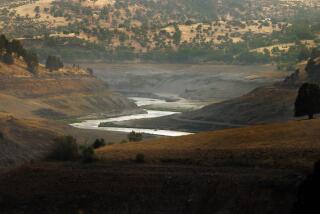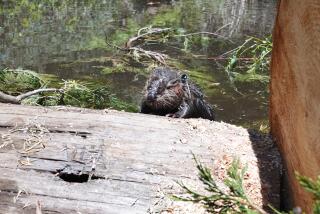Maine’s 70,000 Prolific Beavers Keep State Biologist Busy as--a Beaver
SABATTUS, Me. — Maine’s prolific beavers are busier than ever this fall, stopping up streams, clogging culverts and flooding fields and woodlands.
For state biologist G. Keel Kemper, that means about a half dozen phone calls a day from residents complaining about those clever beaver dams.
It’s Kemper’s job to keep the waterways open, but with minimal disturbance to the beavers’ intricate structures.
Beavers are especially active in the fall, when they build homes and gather food--tree bark and wood--for the winter. Kemper, however, rules out relocating beavers in the fall, since that would force them to restart their home-building process and could, in effect, sentence them to a slow death.
To Kemper, Castor canadensis is too valuable a species to dislodge and send packing just because the beavers follow their instincts to dam up waterways.
“There’s no question the beaver is the most important animal to all other animals, because he can alter habitats,” said Kemper. “If I move him down the road, I’m just moving my problem down the road.”
Killing beavers is not an option. Maine’s policy is to avoid killing nuisance animals unless it’s a last resort.
Over-hunting in the 19th Century nearly wiped out the beaver in Maine. Later, trapping regulations helped the creature return slowly. Over the last few decades, a sharp drop in demand for beaver furs and forest-cutting practices that create good forage have sent the state’s beaver population soaring toward pre-Colonial levels.
Maine now has an estimated 70,000 beavers, about the number it can adequately support. Signs of nature’s most tireless builders are evident along many of the state’s waterways.
At Jean Pratte’s spread in Sabattus in southern Maine, a 6-foot-high dam made of gnawed sticks and branches tightly packed with mud spans a 30-foot-wide stream, raising the water level of an extensive marsh by more than three feet.
The edge of the marsh and a nearby woodland are marked by stumps efficiently gnawed by razor-toothed beavers.
Across the marsh, a yellowish tinge on softwood trees provides evidence that the high water is taking a toll on the evergreens.
Pratte, afraid the rising marsh would destroy up to 40 acres of commercial timber, called Kemper for help.
Kemper arrived with an assistant, a canoe, several lengths of perforated pipe and waders. The two went right to work.
Balancing himself in a canoe with the grace of a tightrope walker, the wiry biologist swung a sledgehammer to drive several steel stakes into the stream bed about 10 feet from the head of the dam.
After attaching five 6-inch diameter pipes to the stakes, he rested the 20-foot-long pipes on top of the dam. The perforated pipes prevent the beavers from undoing Kemper’s work by blocking the intake end.
Kemper and his assistant, Steve Saucier, then went to work with pickaxes and their bare hands, digging troughs into the top of the dam. As they placed the pipes through the openings, water gushed into the stream below the dam. The level at the high-water side dropped a half-inch within an hour. The dam remained intact.
Kemper said he was sure the beaver would be back to make repairs.
“By their instincts, beavers don’t like the sound of running water,” said the biologist. “When he returns, he’ll come back with sticks in his mouth.” Biologists don’t know exactly why the water sound prompts beavers into action.
To help get the beaver started on the reconstruction, Kemper and Saucier shoved a few sticks into the top of the dam and placed some more limbs across the structure.
In the last year alone, Kemper said, the state put pipes through 48 beaver dams and gave equipment to dozens of other landowners to do the job themselves. The federal government pays for the pipes because it endorses Maine’s strategy to preserve freshwater wetlands.
The beaver dams preserve marshes, which are a critical habitat for a whole range of creatures from worms and grubs to ducks, birds, raccoons, skunks, deer and moose.
Repeated cycles of ripping out dams only to have them replaced by eager beavers cause rapid fluctuations in the level of marshes, diminishing their value as animal habitats.
And tearing out dams sends silt downstream, which is bad for fish.
Of course, beavers don’t always choose the right places to build dams; one of their favorite places, for example, is in culverts under highways. That’s when Kemper hears from town road officials.
Kemper used to crawl into the culverts and prod the dams loose by hand, but the resulting gushes of water convinced him to take another approach.
“I’ve been spit out of the end of more than one culvert,” he said.
Trapping and relocating beavers are more practical in the spring, when the beavers can adapt more easily to new places and have more time to build new lodges.
More to Read
Sign up for Essential California
The most important California stories and recommendations in your inbox every morning.
You may occasionally receive promotional content from the Los Angeles Times.










